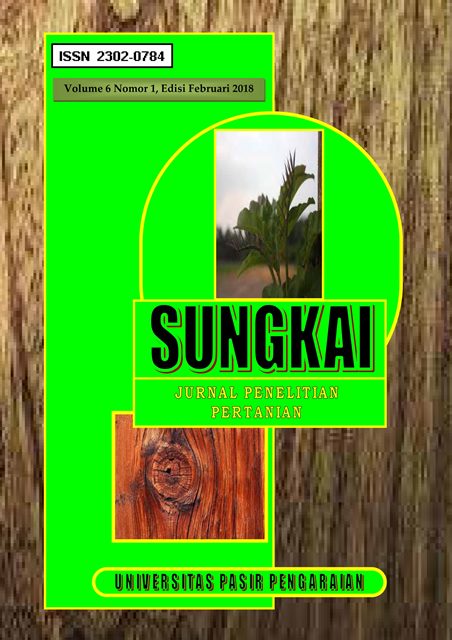PEMBUATAN PUPUK ORGANIK BOKASHI DARI TEPUNG IKAN LIMBAH PERIKANAN WADUK CIRATA
DOI:
https://doi.org/10.30606/js.v6i1.1517Keywords:
Bokashi organic fertilizer, Cirata Reservoir, fisheries waste, fish mealAbstract
Dead fish after upwelling in Cirata Reservoir might cause environmental pollution if it is not well managed. A solution that can be used is utilizing the waste into bokashi organic fertilizer. The purpose of this research were to process fish wastes into bokashi organic fertilizer that meet standards of SNI, and to apply on kale growth. Research was divided into three stages. The first stage was production of fish meal from Cirata Reservoir fisheries waste. The second stage was production of bokashi organic fertilizer by mixing fish meal, rice bran and coconut dregs with fish meal concentration of 30%, 40%, 50% and 60%. The third stage was fertilizer application on kale. Bokashi organic fertilizer product had organic C of 13,98%-17,77%, N total of 3,23%-7,80%, C/N ratio of 1,69-5,50, P total of 1,46%-2,90%, and K total of 0,92%-1,46%. In general, bokashi organic fertilizer product did not meet standard of SNI because C/N ratio was below the standard. Bokashi organic fertilizer with 30% fish meal combination resulted the highest kale growth (p < 0,05).References
[AOAC] Association of Official Analitycal of Chemist. 2007. Official Methods of Analysis of AOAC International. 18th Edition, 2005. Current Through Revision 2, 2007. Gaithersburg, Maryland, USA: AOAC International.
Aguilera E, Lassaletta L, Sanz-Cobena A, Garnier J, Vallejo A. 2013. The potential of organic fertilizers and water management to reduce N2O emission in Mediterranean climate cropping systems. Agriculture, Ecosystems and Environment 164: 32-52.Crawford JH. 2003. Composting of agricultural waste. Biocycle 42 (10) : 68-77
[BSN] Badan Standarisasi Nasional. 1992. Cara Uji Makanan dan Minuman. SNI 01-2891-1992.
[BSN] Badan Standarisasi Nasional. 2004. Spesifikasi Kompos dari Sampah Organik Domestik. SNI19-7030-2004.
Crawford JH. 2003. Composting of agricultural waste. Biocycle 42 (10) : 68-77
Deng J, Mai K, Ai Q, Zhang W, Wang X, Xu W, Liufu Z. 2006. Effects of replacing fish meal with soy protein concentrate on feed intake and growth of juvenile Japanese flounder, Paralichthys olivaceus. Aquaculture 258: 503-513.
Graves RE, Hattemer GM, Stettler D, Krider JN, Dana C. 2000. National Engineering Handbook. United States: Department of Agriculture.
Goyal S, Dhull SK, Kapoor KK. 2005. Chemical and biological change during composting of different organic waste and assessment of compost maturity. Bioresource Technology 96 : 1584-1591.
Hidayati YA, Harlia E, Marlina ET. 2008. Analisis kandungan N, P, dan K pada lumpur hasil ikutan gasbio (sludge) yang terbuat dari feses sapi perah. Prosiding Seminar Nasional Teknologi Peternakan 2008, hlm. 271-275.
Ibrahim B. 2005. Kaji ulang sistem pengolahan limbah cair industri hasil perikanan secara biologis dengan lumpur aktif. Buletin Teknologi Hasil Perikanan 8 (1): 31-41.
Kastaman R, Herwanto T, Iskandar Y. 2006. Rancang bangun dan uji kinerja kompos skala rumah tangga. Jurnal Agrikultura 11 (17): 1-10.
Komarawidjaja W, Sukimin S, Arman E. 2005. Status kualitas air Waduk Cirata dan dampaknya terhadap pertumbuhan ikan budidaya. Jurnal Teknologi Lingkungan 6 (1): 268-273.
Laos F, Mazzarino MJ, Walter I, Roselli L. 1998. Composting of fish waste with wood by-product and testing compost quality as a soil amendment: experiences in Patagonia region of Argentina. Compost Science & Utilization 6 (1): 59-66.
Mayer J, Scheid S, Widmer F, Fließbach A, Oberholzer HR. 2010. How effective are ‘Effective microorganisms (EM)’? Results from a field study in temperate climate. Applied Soil Ecology 46: 230-239.
Ndegwa PM, Thomson SA. 2000. Effect of C-to-N ratio on vermin composting of biosolid. Bioresource Technology 75: 7-12.
Pramaswari IAA, Suyasa IWB, Putra AAB. 2011. Kombinasi bahan organik (Rasio C:N) pada pengolahan lumpur (sludge) limbah pencelupan. Jurnal Kimia 5 (1): 64-71.
Ruhnayat A. 2007. Penentuan kebutuhan pokok unsur hara n, p, k untuk pertumbuhan tanaman panili. Buletin Littro 18 (1): 49-59.
Santoso B, Budi US, Nurnasari E. 2012. Pengaruh jarak tanam dosis pupuk NPK majemuk terhadap pertumbuhan, produksi bunga dan analisis usaha tani rosella merah. Jurnal Littri 18 (1): 17-23.
Subowo YB, Sugiharto A, Suliasih, Widawato S. 2010. Pengujian pupuk hayati untuk meningkatkan produktivitas tanaman kedelai (Glicine max) var. baluran. Jurnal Cakara Tani 25 (1): 112-118.
Supadma AAN, Arthagama DM. 2008. Uji formulasi kualitas pupuk kompos yang bersumber dari sampah organik dengan penambahan limbah ternak ayam, sapi, babi, dan tanaman pahitan. Jurnal Bumi Lestari 8 (2): 113-121.
Susila AD. 2006. Panduan Budidaya Tanaman Sayuran. Bogor: Departemen Agronomi dan Holtikultura, Fakultas Pertanian, Institut Pertanian Bogor.
Sutanto R. 2002. Pertanian Organik. Yogyakarta: Kanisius.
Syafei LS. 2005. Penebaran ikan untuk pelestarian sumberdaya perikanan. Jurnal Ikhtiologi Indonesia 5 (2): 69-75.
Usman. 2012. Teknik penetapan nitrogen total pada contoh tanah secara destilasi titimetri dan kolorimetri menggunakan autonalyzer. Buletin Teknik Pertanian 17 (1): 41-44.
Wei YS, Fan YB, Wang MJ, Wang JS. 2000. Composting and compost application in China. Resource,Conservation and Recycling 30 : 277-300.
Xiaohou S, Min T, Ping J, Weiling C. 2008. Effect of EM Bokashi application on control of secondary soil salinization. Water Science and Engineering 1(4): 99-106.

